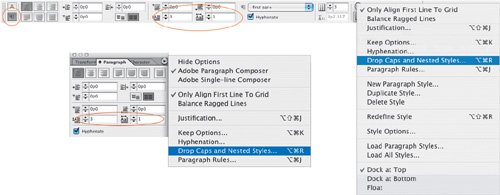Creating a Simple Drop Cap
Contemporary magazine and book publishing continues this centuries-old tradition with the convention of beginning s and articles with large initial letters. Creating a simple drop cap is a breeze in InDesign and can be applied locally or incorporated into a style sheet definition. You create drop caps locally using the Control palette or the Paragraph palette. I prefer the Control palettethat way I don't need my Paragraph palette open, cluttering up my workspace. If you plan to apply the same formatting to more than one paragraph in your document, it saves time (and ensures consistency) to incorporate the drop cap attributes into a paragraph or style definition. The drop cap style is commonly based on your body text style with any first-line indent removed and with some space added before the paragraph. Figure 10.2. The Control palette showing Paragraph Formatting Controls selected.Two ways to apply a drop cap: using the controls on the Control palette (left) or using the palette fly-out menu (right). Type a number for Drop Cap Number of Lines, then specify the number of drop cap characters you wantusually one, but as we'll see this isn't always the case. The Paragraph palette found under the Type menu (Cmd+Option+T/Ctrl+Alt+T), showing the drop cap fields (Drop Cap Number of Lines, Drop Cap One or More Characters), as well as the Drop Caps and Nested Styles palette menu option. [View full size image] 
Figures 10.3A and 10.3B. Applying a drop cap as part of a style sheet definition:Choose New Paragraph Style from the Paragraph Styles palette. To edit an existing style, Ctrl-click (right mouse click) on the style and choose Edit. Name the style"first par," "body first" are common naming conventions. If you have your body text style, you may want to base your "body first" on this. Choose body from the Based On: pull down menuin the example shown I am basing the drop cap on the no indent version of the body text style, which itself is based on "body." Choose Drop Caps and Nested Styles from the list in the left column. Specify the number of lines, i.e., how many lines to sink the first character, and the number of charactershow many characters you want to make big. If you have a character style defined you can apply that here, too, using the Character Style pull-down menusee below. In InDesign terminology, this is "nesting" the character style inside the paragraph style. (See Chapter 14: Mo' Style) [View full size image] 
|







